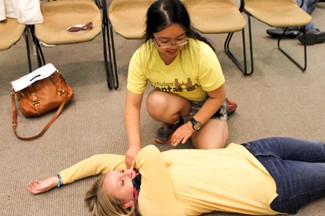Every second counts when it comes to treating acute alcohol poisoning.
“We have a lot of student leaders on campus, but sometimes people might be uncomfortable taking direct steps to intervene,” said Brian Dulin, coordinator of the University of Idaho”s Alcohol and Other Drug Abuse program.
The bystander effect is a phenomenon in which individuals do not offer to help someone in need because they believe someone else is taking care of them.
It”s an occurrence that Dulin said is not only surprisingly common, but also particularly dangerous when it comes to drinking at college parties.

Irish Martos | Argonaut
Elizabeth Kang and AOD Intern Ashtin Mitchell re-enact a recovery position in case of alcohol poisoning during an alcohol bystander intervention workshop Sept. 15.
Dulin, who spoke to an audience of students, faculty members and Greek advisers at The Red Watch Band alcohol bystander intervention workshop Tuesday, said the worst part about the bystander effect when alcohol is involved is that the ultimate consequence can be death.
The workshop was an interactive presentation about the dangers of alcohol poisoning as well as the ways in which individuals can aid those who show signs of acute alcohol poisoning.
Dulin said the presentation, a Safety Week event put on by UI”s AOD program, had a large turnout from a number of different living groups.
“We”re a fairly new program, just shy of two years old and while we hosted a screening last year, this was our first presentation,” Dulin said. “The turnout at this event was great – lots of representation from sororities, fraternities and residence halls.”
During the presentation, Dulin said the best way to step up and combat the bystander effect is to follow three steps. Dulin urged students to keep an eye out for individuals who might be drinking excessively or are exhibiting signs of alcohol poisoning.
He said students should intervene in the event of seeing someone at risk by asking them how much they”ve had to drink, and if they have been mixing alcohol with any other substances.
Finally, Dulin said step three is to assume responsibility by taking control of the situation and calling for help.
“If the skin is pale, clammy or bluish, if they”re cold to the touch, if they”re unconscious and won”t respond or they”re vomiting while unconscious – then they probably have acute alcohol poisoning,” Dulin said, mentioning someone should then call for help and turn the person on their side so they do not asphyxiate.
In addition to the “step-up” process, Dulin said there are a number of alternative ways to prevent alcohol poisoning. These ways to intervene include the distraction model, which is finding a way to distract the individual from drinking, such as by offering to get something to eat or take a break from drinking and delegating responsibility to someone else.
While the presentation”s central focus was how to overcome the bystander effect, Dulin said the AOD program will hold an alcohol screening next Wednesday where students can gauge and evaluate their relationship with alcohol.
“The screening helps students learn more about their drinking behavior and their relationship with alcohol,” Dulin said.
Dulin said these screenings are also valuable to the program itself as it allows AOD members to find new ways to better reach out to students in the future.
“Workshops like this prompts students to think about alcohol poisoning and also to equip them with knowledge they can use later down the road,” Dulin said.
Corrin Bond can be reached at [email protected]
